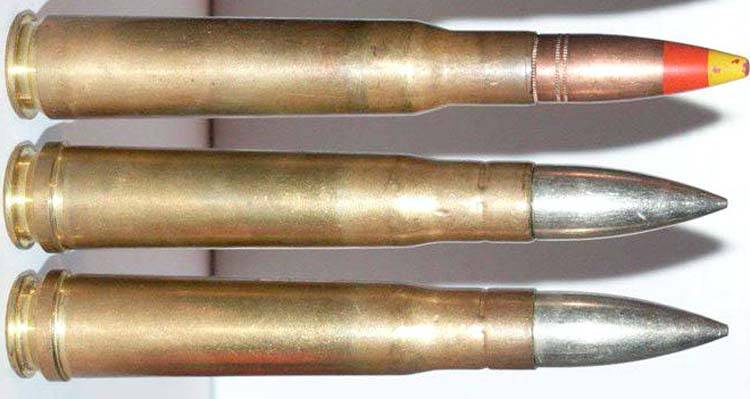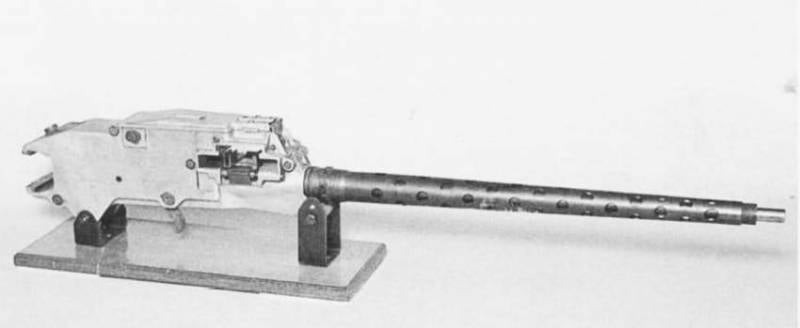Large-caliber machine gun Rolls Royce Experimental Machine Gun (UK)
By the beginning of the war, there was a certain number of large caliber machine guns 15 mm BESA, also known as ZB-60, in the land forces of Great Britain. This weapon was developed by Czechoslovak designers from the late twenties. In the 1937, the British Army received a modification of such a machine gun chambered for 15x104 mm. The machine gun could be used by infantry, as well as on various armored vehicles. At the same time, the installation of such a machine gun on aircraft was virtually excluded.
At the beginning of 1940, Rolls Royce proactively proposed the development of a new large-caliber machine gun suitable for use in various fields. By reducing the size and mass of these weapons could become an infantry, tank or aviation. Soon, the company's specialists, headed by the designer Spirito Mario Viale, began to study the tasks and possibilities, and then formed several technical proposals.
In the future, these works led to the emergence of a full-fledged project. It is noteworthy that this development has not received any special designation. The new weapon was called simple and clear: Rolls Royce Experimental Machine Gun (“Experimental Machine Gun Rolls Royce”). Perhaps, in the future, the product, having entered into service, could receive a designation corresponding to the army nomenclature of that time.
Before starting the development of a machine gun gunsmiths had to choose ammunition for him. Considered a British large-caliber cartridge 12,7x81 mm Vickers and American 12,7x99 mm. The latter was distinguished by high technical and combat characteristics, and was also produced and delivered in large quantities, which made it possible to organize the operation of weapons in the army. The British large-caliber cartridge, in turn, found unsuitable for use on the totality of characteristics.
The machine gun could get automatic on the basis of the gas engine or using a short recoil of the barrel. Calculations showed that a machine gun with a vapor node will be larger and heavier, and will also receive a limited rate of fire. Automatics with a moving barrel had no such problems. It was she who made it possible to create a more successful machine gun for combat aircraft.
Mass machine gun failed to reduce due to the maximum ease of the receiver. This problem was solved with the help of optimal external and internal circuits, as well as through the use of lightweight materials. The loaded units were proposed to be cast from aluminum alloy RR50, developed by Rolls-Royce specifically for the manufacture of engine crankcases. According to some reports, aluminum parts were about three times lighter than steel, having the same configuration.
The machine gun, built with the use of new materials, was to be based on already known ideas in the field of design. Thus, a proven and proven layout was proposed. The main parts were to be placed inside the receiver of a complex shape. In its front wall was fixed trunk, covered with a conical perforated casing. Above the breech of the trunk was located a node for receiving the tape with cartridges. In the central and rear parts of the box were placed a movable shutter and firing mechanism.
The barrel of the experimental machine gun was divided into two main parts. The bottom element formed the bottom, and its front part had a ring for mounting the barrel. The top lid of the box was large. At its front were the windows for feeding the tape; the rear unit had a U-shaped section and covered all the main parts. In the back of the cover, characteristic protrusions were provided, which are necessary for fastening the weapon on the aircraft’s power set. In front of the receiver, above the mount the trunk and its casing, there was a hinge. For servicing the machine gun cover could fold back and forth. The connection of the two elements of the box was carried out with the help of several pins.
The machine gun received a rifled barrel length 1017 mm (80 calibers). This detail was similar to the barrel of the American machine gun M2, but it had noticeable differences. So, the number of rifling was reduced to four. Changed and their steepness. Such processing resulted in a slight reduction in the initial speed of the bullet, however, it allowed to obtain an increased rate of fire. The barrel did not have a rigid attachment and during firing could perform reciprocating movements along its longitudinal axis. This design, in particular, has allowed to simplify the replacement of the barrel.
According to the results of the preliminary study, the automation was selected based on the recoil of the barrel with its short stroke. The machine gun had a moving barrel, when fired, it interacted with a massive bolt. The latter received a pair of lever accelerators, which made it possible to further increase the rate of fire. Taking into account the use of weapons on planes, the authors of the project introduced shooting from a closed bolt. This simplified the integration of the synchronizer for shooting through the screw.
The Rolls Royce Experimental Machine Gun was supposed to use 12,7x99 mm cartridges fed by standard American-made loose ribbons. The tape was supposed to flow into the weapon through the left window of the receiver. Empty links were thrown through a window in the right wall.
The new machine gun was quite compact and light. The total length of the product was 1,27 m, weight - 22,25 kg. Thus, this sample turned out to be shorter and lighter than all existing analogues. The initial speed of the bullet was only 713 m / s, which was compensated by the rate of fire at the level of 1000 shots per minute. The effective range, according to calculations, reached 2200 yards (1800 m).
The development of a large-caliber machine gun was completed at the beginning of the 1941 of the year, and soon the first prototypes were assembled. In March, they were sent to the Pandin Sands test site. In the course of these inspections, a prototype weapon was fixed on a test bench and fired at various targets. Both the strengths and weaknesses of the project were quickly identified.
The undoubted advantage was a high rate of fire, which increased the potential of the machine gun as an aircraft weapon. Reduced dimensions simplified installation of the machine gun on existing and future fighters. Low weight, in turn, made it possible to increase the ammunition in comparison with other large-caliber machine guns. The 12,7x99 mm cartridge made it possible to avoid potential problems with the supply of ammunition.
However, it was not without flaws and problems. Already during the first firing, it was found that the Rolls Royce Experimental Machine Gun had an unacceptably large torch on a muzzle cut. As it turned out, because of the smaller steepness of the rifling bullet passed through the barrel faster than in the case of other similar systems. The powder charge of the cartridge did not have time to completely burn before the bullet emerged from the barrel, which led to the release of burning particles through the barrel. In order to avoid difficulties associated with the presence of such a flash, the machine gun was soon equipped with a flame arrester. A conical part appeared on the muzzle cut, reducing the torch.
A characteristic feature of the large-caliber machine gun from Rolls-Royce was the relatively low initial speed of the bullet. This was not a problem when using weapons on airplanes, but drastically reduced its potential in the context of "ground" combat missions. Thus, the machine gun could not be effectively used by the army as an infantry weapon or as part of the armament of armored vehicles.
Despite such problems, the experimental machine gun was very successful and was of some interest to the armed forces. As a result, a proposal appeared, with the successful implementation of which new aircraft could be received by aircraft, infantry and armored troops. In order to improve the effectiveness of the machine gun in the fight against land targets, it was proposed to develop a specialized modification for a different cartridge.
The new machine gun, designed for the army, was supposed to use the serial large-caliber cartridge 13,9x99 mm B. At that time, this ammunition was used only with an anti-tank gun Boys. Such a modernization of the machine gun made it possible to obtain a sharp increase in the main fire characteristics. The finished model, characterized by high energy performance, could occupy an intermediate position between serial rifle and large-caliber machine guns and 20-mm artillery systems.
However, the 13,9x99 mm B cartridge quickly had to be abandoned. The British industry at that time struggled with serious difficulties, and therefore the rate of production of cartridges for anti-tank guns were relatively small. The increase in production, which allowed to ensure the exploitation of machine guns, was associated with certain problems. In addition, economic difficulties were soon revealed. At that time, the industry was rolling out the release of armor-piercing 13,9-mm bullets with a steel core. Instead, it was now planned to manufacture products with a core of tungsten, which was distinguished by better characteristics and higher cost. The use of such a cartridge with a machine gun was considered unacceptably expensive and impractical.

Large-caliber cartridges: .50 BMG (top) and 13,5х99 mm B Boys (in the middle and bottom)
The lack of a sufficient number of cartridges and their excessive cost quickly enough led to the refusal to create a new modification of the Rolls Royce Experimental Machine Gun. As far as is known, this project has not left the drawings and was not brought even to the assembly of prototypes.
Rolls Royce continued to work on a large-caliber machine gun until the start of 1942. During this time, it was possible to conduct a lot of various tests and make various changes to the project, correcting the errors that had existed and improving the basic parameters. After such a refinement, the weapon could cope with all the tests and receive a recommendation for adoption.
However, this did not happen. By the beginning of 1942, full-scale shipments of weapons and other military products from the United States were deployed. Among other products, under the program "Lend-Lease" the British army received large-caliber machine guns Browning M2 in the infantry and aviation configuration, as well as ammunition for them. In the shortest possible time, imports have completely covered all the needs of the UK in such weapons.
Receiving a large number of foreign machine guns made it possible to carry out the desired rearmament, without wasting time and resources on launching a new production. At the very beginning of 1942, the Rolls Royce heavy machine gun project was closed. The company continued to work in the field of automotive technology and aircraft engines. CM. Viale and his colleagues soon proposed new product designs that could positively affect the combat capability of the armed forces.
The project "Experimental heavy machine gun" was a response to specific challenges associated with the peculiarities of the existing range of weapons and the complexities of the initial period of war. The machine gun had some advantages, but the full implementation of all the ideas was associated with certain difficulties and demanded a lot of time. By the time the roll-out of the Rolls-Royce machine gun was completed, the British army had time to order and receive foreign weapons in sufficient quantities. Issuing their own weapons now did not make sense. The Rolls Royce Experimental Machine Gun project did not produce the desired results. However, in that situation, the main task was to get a new weapon, regardless of the country of production.
On the materials of the sites:
http://airwar.ru/
http://beforeitsnews.com/
http://modernfirearms.net/
http://strangernn.livejournal.com/
- Ryabov Kirill
- Airwar.ru, Strangernn.livejournal.com




Information